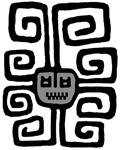Center, Textile Research

PreColumbian Textile Conference VIII / Jornadas de Textiles PreColombinos VIII (2019)
Date of this Version
6-2020
Document Type
Article
Citation
DOI: 10.32873/unl.dc.zea.1207
Published in PreColumbian Textile Conference VIII / Jornadas de Textiles PreColombinos VIII, ed. Lena Bjerregaard and Ann Peters (Lincoln, NE: Zea Books, 2020). https://digitalcommons.unl.edu/zeabook/
Abstract
A raíz de la ejecución del Proyecto de Rescate Arqueológico Parcial en Cerro la Horca, fue posible el registro de diversas evidencias materiales las cuales han puesto de manifiesto nuevas interpretaciones sobre la ocupación del sitio. La recuperación de material textil y su respectivo análisis ha permitido identificar y definir diversos estilos textiles, entre los que podemos citar: Lambayeque, Huarmey, Chancay, Serrano, Chimú e Inca los mismos que revelan la compleja y variada interacción socio-cultural de los diversos grupos étnicos que convivieron en esta parte baja del valle del Fortaleza, durante el Periodo Intermedio Tardío y Horizonte Tardío.
During the execution of the Partial Salvage Archaeological Project at Cerro la Horca it was possible to record a variety of material evidence, which has revealed new interpretations of the occupation of the site. According to the textile analysis there are at least seven textile styles: Lambayeque, Huarmey, Fortaleza, Chancay, Chimú, Serrano and Inca which reveal a complex socio-cultural interaction between different ethnic groups who inhabited this lower part of the Fortaleza valley during the Late Intermediate Period and Late Horizon.
Suite à la réalisation du Projet de Sauvetage Archéologique Partiel à Cerro la Horca, il a été possible de constater diverses évidences matérielles qui ont suscité de nouvelles interprétations sur l’occupation du site. La découverte des textiles et leur analyse a permis d’identifier et de définir différents styles textiles, parmi lesquels nous pouvons citer: Lambayeque, Huarmey, Fortaleza, Chancay, Chimú, Serrano et Inca qui révèlent une interaction socio-culturelle complexe entre les différents groupes ethniques qui habitent dans cette partie basse de la vallée de Fortaleza durant la Période Intermédiaire Récente et l’Horizon Récent.
Included in
Art and Materials Conservation Commons, Fiber, Textile, and Weaving Arts Commons, Indigenous Studies Commons, Latin American Languages and Societies Commons, Museum Studies Commons, Other History of Art, Architecture, and Archaeology Commons


Comments
Copyright 2020 Arabel Fernández L. & Luis Valle A.